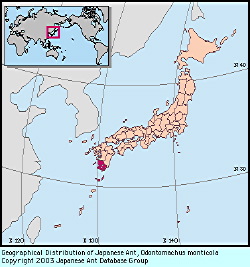
|
species
|
Odontomachus monticola
|
 |
Original Reference
|
|
Emery, C. (1892) Voyage de M. Ch. Alluaud dans le territoire d'Assinie (Afrique occidentale) en juillet et aoět 1886. Formicides. Annales de la Société
Entomologique de France 60: 553-574.
|
Synonym
|
|
Myrtoteras kuroiwae Matsumura, 1912,
Odontomachus monticola var. formosae Forel, 1912,
|
Description
|
|
A large ponerine ant: total length of workers around 10 - 13 mm. Body color blackish brown to dark brown. Truncate (subapical) tooth of apical mandibular dentition short, only about 1.5 times as long as wide. Posterior dorsum of head covered with fine striation.
|
Remarks
|
|
This species nests under stones and rotten wood. When escaping, workers will often jump backwards for some centimeters propelled by the force of their jaws snapping on the ground. On Yaku Island it occurs at altitudes as high as 1200m. O. monticola is widespread in Asia, including India, Myanmer, mainland China and Taiwan. In China, its range extends north of Beijing to beyond 40 degrees N latitude (Teranishi, 1936, the species there reported as O. haematodus Linnaeus; see also Yasumatsu, 1962).
|
|

Distribution
|
|
Kyushu (Kagoshima Pref.), Yaku I., Tanegashima I., Kuchinoerabu-jima I.; Mainland China, Taiwan, SE Asia, Myanmer, India.
|
|
References
|
|
- Matsumura, S. 1912. Thousand insects of Japan. Supplement IV. 247 pp. Keishu-sha, Tokyo.
- H. Sauter's Formosa-Ausbeute: Formicidae. Entomologische Mitteilungen 1: 45-81.
- Teranishi, C. (1936). Insects of Jehol (VII), Family Formicidae. . Rep. 1st Sci. Exp. to Manchoukuo (5)Part 11Article 60, 1-12, .
- Yasumatsu, K. (1962). Notes on synonymies of five ants widely spread in the Orient. . Mushi, 36, 93-97.
|
Editor
|
|
Original text by Masaaki Morisita. Revised by Masashi Yoshimura. English translation by Kazuo Ogata and Keiichi Onoyama, edited by Robert W. Taylor.
|
|